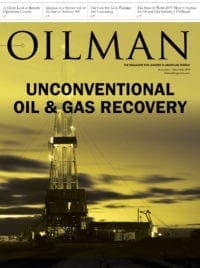Challenges abound in the oil and gas industry: from navigating unpredictable – and often treacherous – weather conditions to maintaining production levels and ensuring the safety and security of staff and equipment across a range of locations. It’s clear to see the role mission-critical communications technology plays in the smooth operation, safety and efficiency of both headquartered and remote worksites.
This importance is reflected in the rapid development of communications technologies. The two-way radios and daily reports of the late 1980s have evolved into the Wi-Fi connectivity, personal smartphone use and real-time data transfer capabilities of today, and the benefits of such are clear – with the new technologies allowing for remote, unmanned, and subsea developments.
Needless to say, the oil and gas industry has been transformed by improved communications systems, and one such system ushering in the next stage of communications technology and efficiency is mobile device management, or MDM.
At a base level, MDM allows companies to manage, control, and create security policies on company-deployed mobile devices. But the capabilities of MDM go much further than this; with some solutions offering features beneficial to the oil and gas industry, like bulk, two-way file transfer capabilities, remote control for unmanned devices and grouping capabilities.
However, not all MDM solutions are created equal. For oil and gas companies looking to invest in MDM technology, the following five features should be considered:
Two-Way Bulk File Transfer Capabilities
One of the biggest communication challenges in having a remote and varied workforce is the transfer of large files and amounts of data. Manually sending files and data, one-by-one via email channels is time-consuming and frustrating for personnel, and many companies can do without incurring the cost of sending technicians to remote worksites to install important updates. With this in mind, the need for simple and reliable two-way data transfer channels is obvious.
As such, companies should seek an MDM solution with two-way, bulk file transfer capabilities that enable staff at remote facilities to transfer large files through a secure TLS, or similar, encrypted channel.
Application Management Services
Oil and gas industry-specific applications have emerged since the popularity boom of smartphones, and it’s clear to see why: they simplify certain processes within each sector of the oil and gas industry while providing easy access to information. As such, another essential function to look for in an MDM solution is an Application Management Services suite, also referred to as an AMS suite.
An AMS suite enables companies to create their own ‘app store,’ where company-developed, process-specific applications can be customized, branded and remotely deployed to company devices, without any interaction with the end-user. Companies can also take advantage of the force install feature which makes sure critical security updates are installed on all devices, leaving no room for potential exposure to security threats. They can also use the staged rollout feature which enables updates on only a certain percentage of devices so that if there are any system-breaking bugs only a portion of devices will be affected.
Remote Control for Unmanned Devices
With the rapid evolution of technology, many processes that previously required human interaction have been automated, such as daily reports. However, this presents several challenges for companies, with the maintenance of these devices and installation of important updates often requiring an IT technician to be on-site. Considering the remote nature of many worksites, this can be a costly exercise.
The right MDM solution will enable oil and gas companies to remotely control their unmanned devices, allowing managers to perform maintenance and deploy important updates through an admin console.
Device Management
With any remote device, sometimes things will inevitably go wrong, and due to the varied worksite locations in the oil and gas industry. Using an MDM solution allows companies to monitor all devices from the dashboard, giving them a bird’s eye view of all deployment operations. On the dashboard, you can see the current home screen status of each device by taking a screenshot and can see detailed device information such as device name, network status, battery status, CPU usage and which group the device belongs to. The dashboard also shows the location of the device which makes it easier to track when moving from one place to another.
Grouping Capabilities
There is a range of employee functions within each stream or sector, so it makes sense that not all employees will need the same tools, applications, information or updates. To streamline the dissemination of information to certain functions or groups, the right MDM solution should offer grouping capabilities.
These capabilities enable companies to define devices by user and function. For example: If a company has engineer-specific information, they can group all engineer devices, and target their file distribution to that group, ensuring personnel only get the resources they need to do their job well.
With the implementation of any new technology, companies need to assess their own unique needs and determine which solution is the right fit. But, following the above suggestions should empower oil and gas companies to embrace MDM technology and reap the benefits of simplified processes, streamlined communication, and increased control and security.
Anson Shiong is CEO of Sand Studio, the developer of mobile device management (MDM) solution for Android devices, AirDroid Business.






